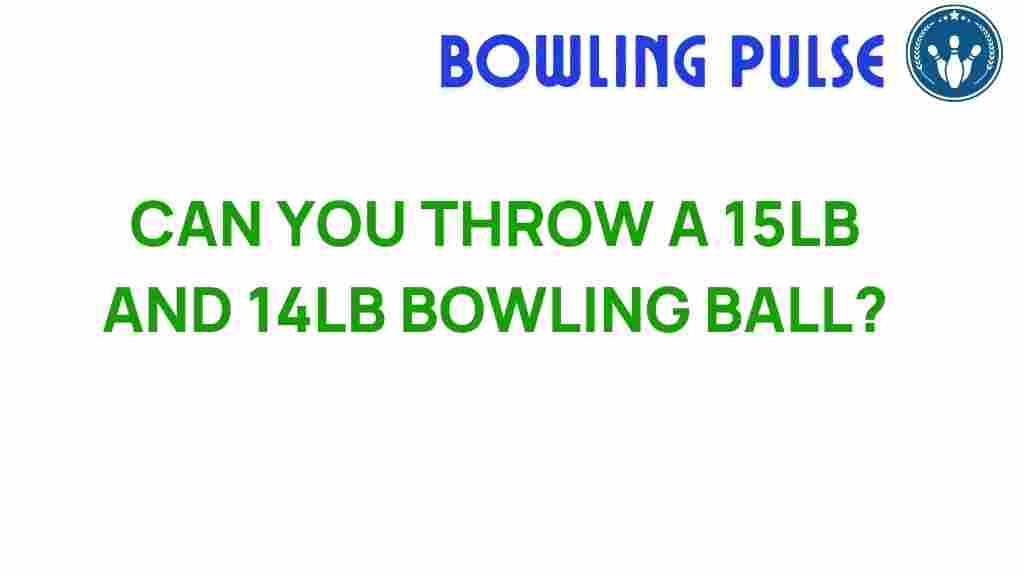The Great Bowling Ball Debate: 15lb vs. 14lb – Weight Comparison
When it comes to the sport of bowling, the choice of equipment can significantly impact your performance and enjoyment of the game. Among the most crucial decisions bowlers face is selecting the right weight of their bowling balls. The debate between using a 15lb versus a 14lb bowling ball is ongoing, with advocates on both sides claiming their weight of choice provides the best results. In this article, we will explore the weight comparison between 15lb and 14lb bowling balls, analyze their effects on various bowling techniques, and ultimately help you determine which one might be the best fit for your game.
Understanding Bowling Balls and Their Weights
Bowling balls come in a variety of weights, typically ranging from 6lb to 16lb. The weight of the bowling ball you choose can influence your throwing technique, your ability to control the ball, and ultimately, your overall performance during a game. It’s essential to consider how the weight impacts not only your game but also your physical capabilities as a player.
Factors Influencing Player Preference
When deciding between a 14lb and a 15lb bowling ball, many factors come into play, including:
- Physical Strength: The strength of your arms and wrists can significantly affect your ability to throw heavier balls. If you find it challenging to control a 15lb ball, a 14lb option might be more suitable.
- Bowling Technique: Different techniques require different approaches to weight. For example, bowlers with a more straightforward delivery may prefer the heavier ball for its power, while those with a more finesse-based approach might opt for the lighter ball.
- Bowling Style: Whether you are a straight bowler, hook bowler, or a two-handed bowler can also dictate which ball weight you should use.
Performance Analysis: 14lb vs. 15lb Bowling Balls
Now, let’s dive deeper into how the weight of your bowling ball can influence your performance in the game.
1. Speed and Control
One of the most notable differences between the two weights is how they affect speed and control:
- 15lb Bowling Balls: Heavier balls can maintain their momentum better and often travel faster down the lane. However, they can also be more challenging to control, especially for bowlers with less upper body strength.
- 14lb Bowling Balls: Lighter balls are generally easier to handle, allowing for greater control and precision. This can be particularly advantageous for bowlers looking to fine-tune their shots.
2. Hook Potential
The ability to hook the ball is crucial for many bowlers. The following points summarize how weight affects this:
- Heavier bowling balls, like the 15lb option, can create more friction on the lane, potentially leading to a greater hook.
- On the other hand, a 14lb ball may allow for a more pronounced hook due to easier wrist movement and more refined control.
3. Impact on Pins
When it comes to striking down pins, weight plays a significant role:
- 15lb bowling balls can deliver a more substantial impact on the pins, increasing the chances of a strike.
- However, a 14lb ball can lead to a more accurate delivery, which can be just as effective in knocking down pins.
4. Fatigue and Stamina
Bowling games can last for hours, and fatigue can become a significant factor:
- Using a 15lb bowling ball may lead to quicker fatigue, especially for amateur bowlers.
- A 14lb ball can help maintain stamina over longer games, allowing for consistent performance.
Bowling Techniques for Different Weights
Your bowling technique plays a crucial role in how effective you will be with your chosen ball weight. Below are some tips tailored for each weight:
Bowling Tips for 15lb Bowling Balls
- Strong Grip: Ensure you have a firm grip on the ball to control it effectively. This will help you maintain accuracy and power.
- Body Positioning: Keep your body aligned and balanced; this is especially important when using heavier balls.
- Follow-Through: A strong follow-through can help maintain speed and accuracy when releasing the ball.
Bowling Tips for 14lb Bowling Balls
- Wrist Action: Focus on using your wrist to generate spin and control the ball’s trajectory.
- Footwork: Smooth and controlled footwork is essential for leveraging the lighter weight for better accuracy.
- Relaxation: Keep a relaxed grip to enhance your timing and release.
Troubleshooting Common Issues
Regardless of which weight you choose, you might encounter some common challenges. Here are some troubleshooting tips:
For 15lb Bowling Balls
- If you struggle to control the ball, consider reducing your speed and focusing on a smoother delivery.
- Ensure your grip is correct; too tight a grip can hinder your release.
For 14lb Bowling Balls
- If you find it challenging to create a hook, experiment with your hand positioning and wrist action.
- Pay attention to your follow-through to ensure you’re not losing power during your delivery.
Conclusion: Which Weight Wins?
The choice between a 14lb and a 15lb bowling ball ultimately comes down to player preference, physical ability, and bowling style. For bowlers seeking power and a more pronounced impact on pins, the 15lb ball might be the better option. Conversely, if control, accuracy, and stamina are your priorities, the 14lb ball could be the ideal choice.
As you navigate the great bowling ball debate, remember that practice and personal experience are invaluable. Test both weights, observe how they affect your game, and make the decision that feels right for you. Always prioritize comfort and control over sheer weight, as these factors will lead to improved performance in your bowling game.
For more tips on improving your bowling technique, check out our comprehensive guide on bowling techniques. If you’re interested in exploring bowling equipment options, visit this resource for more insights.
Happy bowling!
This article is in the category Techniques and created by BowlingPulse Team
